Altivar® 58 TRX AC Drives
Wiring Recommendations
WIRING RECOMMENDATIONS
Good wiring practice requires the separation of control circuit wiring from all power wiring. Power wiring to the motor must have the maximum possible separation from all other power wiring, whether from the same drive controller or other drive controllers; do not run power and/or control or multiple power wiring in the same conduit. This separation reduces the possibility of coupling electrical transients from power circuits into control circuits or from motor power wiring into other power circuits.
Follow the practices below when wiring enclosed ATV58 TRX drive controllers:
•When using metallic conduit, use metal conduit kits; see page 33 for a list of conduit kits.
•Use metallic conduit for all controller wiring.
•Do not run control and power wiring in the same conduit.
•Do not run output wiring from more than one drive in the same conduit.
•Separate metallic conduits carrying power wiring or
•Separate
•Whenever power and control wiring cross, the metallic conduits and
•Equip all inductive circuits near the drive (relays, contactors, solenoid valves) with noise suppressors or connect them to a separate circuit.
Recommendations for Wire Sizing
Refer to NEC Article 430 for the sizing of the branch circuit conductors. All branch circuit components and equipment (such as transformers, feeder cables, disconnect devices, and protective devices) must be rated for the input current of the ATV58 TRX drive controller or the rated output current, whichever value is larger. The input current of the controller depends on the impedance of the power
distribution system and the available fault current at the drive input terminals.
Select the input current corresponding to the available short circuit current capability (AIC Rating) or the line impedance present. If the available fault current capability of the branch circuit is limited by fuses or circuit breakers (not system impedance), use the available fault current capability on the line side of the fuses or circuit breakers to select the drive controller input current. The input current values for the variable torque drive controller ratings are based on nominal NEC rated motor currents. The input current values for the constant torque drive controller ratings are based on drive controller rated output currents. The tables on the following pages provide input current information to optimally size branch circuit conductors.
100
© |
| 09/2003 |
| ||
|
|
|
